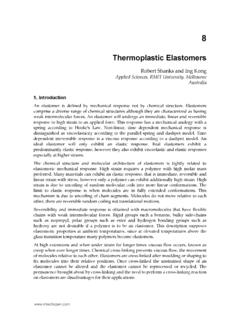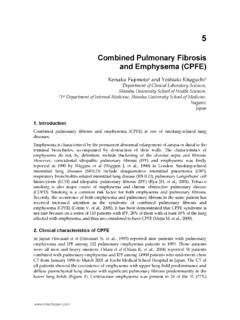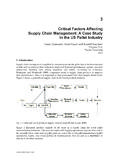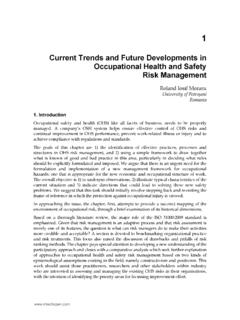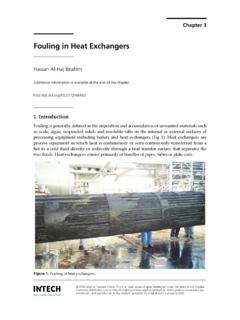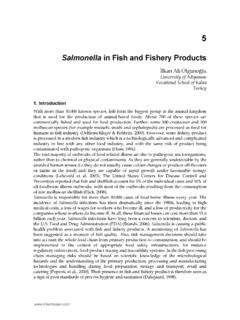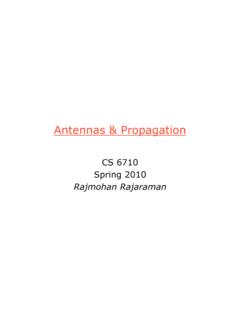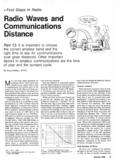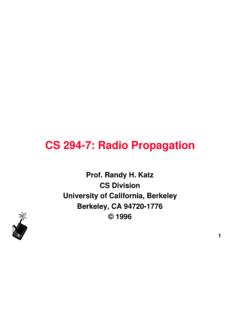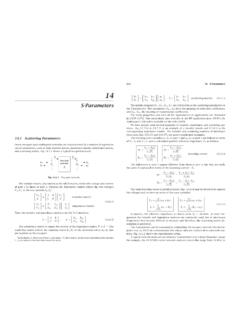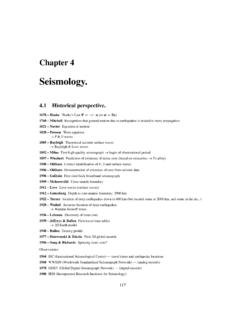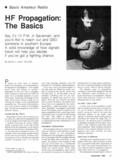Transcription of Radio Wave Propagation Through Vegetation - InTech
1 Chapter 0 Radio Wave Propagation Through VegetationMir Ghoraishi, Jun-ichi Takada and Tetsuro ImaiAdditional information is available at the end of the IntroductionVegetation is an indispensable feature of most outdoor wireless channel environments. Theinteraction between Radio waves and Vegetation has been researched for several of the complex structure of the foliage, composed of randomly oriented trunks,branches, twigs and leaves, the involved physical process in the Propagation of the Radio wavethrough Vegetation is complex. Accurate modeling of the Propagation of Radio waves throughtree foliage, generally requires accurate electromagnetic description of the tree geometry,including its branches and leaves, valid over a wide range of frequencies.
2 Originally empiricalmodels were developed to describe the Propagation of Radio waves in the Vegetation . In otherapproaches this interaction is analyzed using ray-based techniques. More recently theoretical statistical and analytical approaches became favorable. As it is discussed in the next section,major disadvantage of all these models is that the final outcome is basically presented byproviding an excess attenuation to that caused by free space Existing approachesEmpirical models have been developed to characterize the the Propagation of Radio wavesin the Vegetation for years. Their significant advantage is their simplicity.
3 The drawback isthat, like any other empirical model, the formulated model is strictly related to the specificmeasured data set and fails to give any indication as to the physical processes involved in thepropagation within the channel. These models usually provide either the mean attenuationof the Propagation signal caused by Vegetation or calculate the link budget. Parametersin these models, frequency, incident angles, direct-path length Through Vegetation andother parameters associated with the specific environment under which measurements wereperformed, are usually computed Through regression curves fitted to measurement many, the modified exponential decay model suggested in [1], and the COST 235model [2] can be mentioned.
4 These models are expressed as equations in exponential formsto give the specific attenuation as a function of path length and operating frequency. Theattenuation of trees as a function of Vegetation depth has been shown to be more accuratelyrepresented by dual slope attenuation functions [3]-[7]. To accommodate this dual slope, an 2013 Ghoraishi et al., licensee InTech . This is an open access chapter distributed under the terms of theCreative Commons Attribution License ( ),which permitsunrestricted use, distribution, and reproduction in any medium, provided the original work is 62 Will-be-set-by-IN-TECH empirical nonzero gradient model was developed to follow the dual gradient of the measuredattenuation curve [8].
5 The initial slope describes the loss experienced by the coherentcomponent, whereas the second slope describes the dominance of the incoherent component,which occurs at a much reduced rate. An important disadvantage of the semi-empiricalvegetated Radio channel models, common to other approaches such as radiative transfertheory, is that their little account of the dynamic effects in the channel and no account ofthe wideband effects of the Vegetation approach in the the analysis and prediction of the vegetated Radio channel isray-tracing [9]-[16]. These have to be carefully designed and used, taking into account thefrequency of the Radio wave, the dimension of interacting objects and their distance to thesources to fulfill the far field condition.
6 Therefore in different frequencies the mechanismsby which the wave propagates can vary dramatically. The scattering has been modeleddeterministically in many different ways depending on the electrical density of the vegetativemedium. At lower frequencies, where individual components of the Vegetation (trunks,branches, twigs and leaves or needles) and their separations are small by comparison withthe Radio wavelength, considering the Vegetation as a homogeneous dielectric slab, thepropagation has been modeled in terms of a lateral wave at treetop heights [9]. At frequenciesabove 200 [MHz] or so, a single slab becomes inadequate.
7 As the scale of the changesin density and structure of the Vegetation become greater than the order of a wavelength,and layered representations of the Vegetation should be used [10]. A full-wave analysis ofthe radiowave propagating along mixed paths inside a four-layered forest model applicableto frequencies up to 3 [GHz] was proposed in [11], [12], which consists of four isotropicand homogeneous dielectric. The first layer is the semi-infinite free-space, whereas thesecond layer represents the forest canopy. The third and fourth layers model the trunkand the semi-infinite ground plane, respectively.
8 As the distance between the transmitterand the receiver is very long, the Radio wave Propagation Through the stratified forest ischaracterized by the lateral wave that mainly propagates on top of the canopy along theair-canopy interface. For short distances, however, such a Propagation is denominated bythe direct or coherent component. When the receiver is at a clearing distance from the densevegetated area the edge of the forest is treated as a source of diffraction [14], and the uniformtheory of diffraction (UTD) associating a double-diffracted component over the canopy and atransmission component which includes the exact calculation of refraction angles is also used[15].
9 To model the incoherent component which is the dominant Propagation mechanism forlong distances inside Vegetation , theoretical models, which are more complicated but moregeneric and applicable to any arbitrary foliage wave Propagation scenario, are used. Twomajor approaches, namely the radiative transfer theory and the analytical theory, have beenpursued to develop these models [17],[18]. These two methods are closely related as they areaddressing the same problem of the wave Propagation in randomly distributed particles. Infact, the radiative transfer theory can be derived from analytical approach by applying someapproximations [17], and they have proven equivalent for the application of radar in the forestcanopies [19].
10 In the method of radiative transfer theory, the Vegetation medium is modeled as a statisticallyhomogeneous random medium of scatterers which is characterized by parameters such asthe absorption cross-section per unit volume, the scatterer cross-section per unit volumeand the scattering function of the medium [20]. The scattering function (phase function) is156 Wave Propagation Theories and ApplicationsRadio Wave Propagation Through Vegetation3characterized by a narrow forward lobe and an isotropic background. The model considers aplane wave incident from an air half space upon the planar interface of a Vegetation half basic equation of the radiative energy transfer theory is expressed in terms of the specificintensity for which the radiative transfer theory gives the specific value at a given point withinthe Vegetation medium as a sum of a coherent component and an incoherent component.


